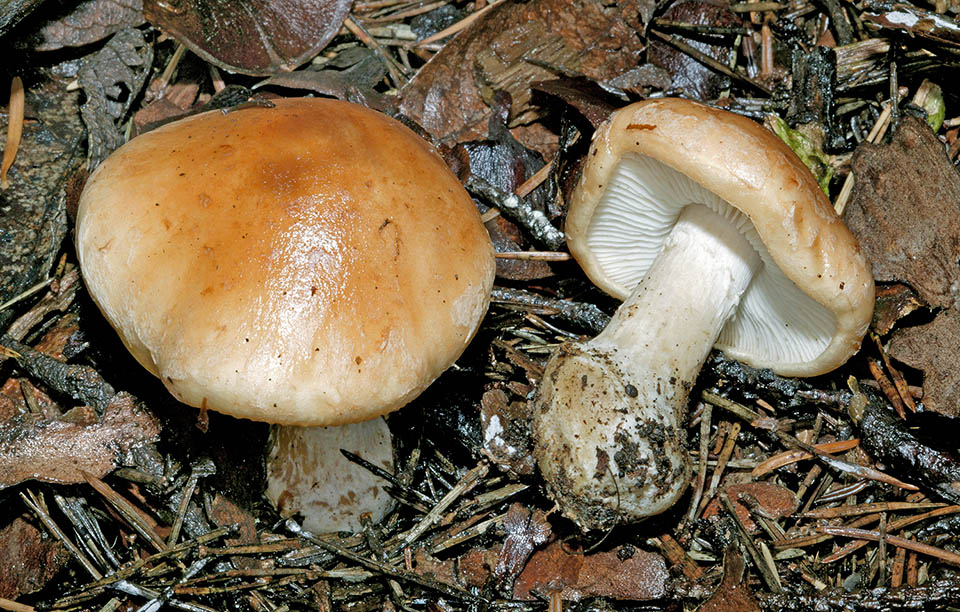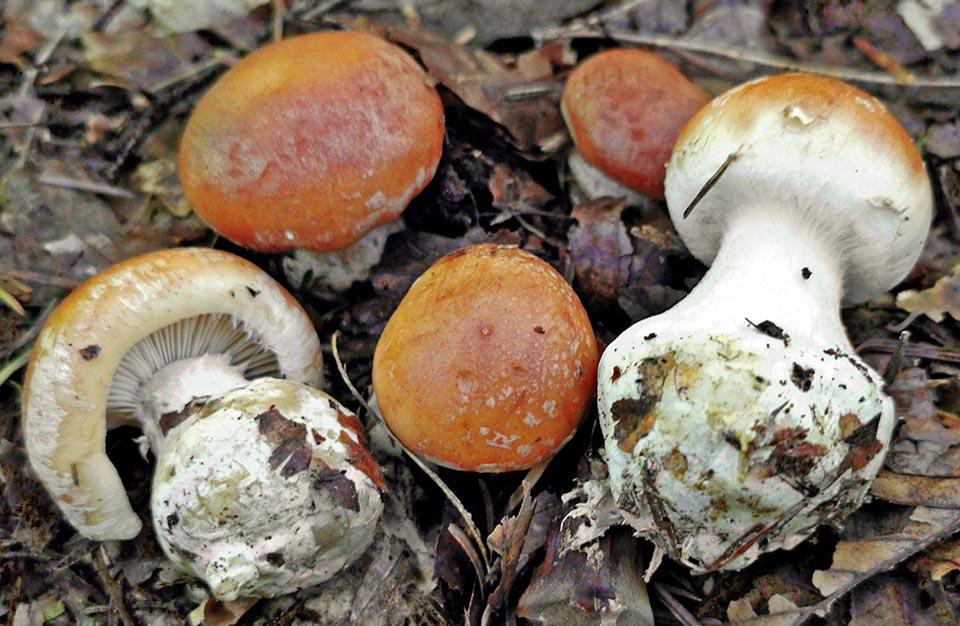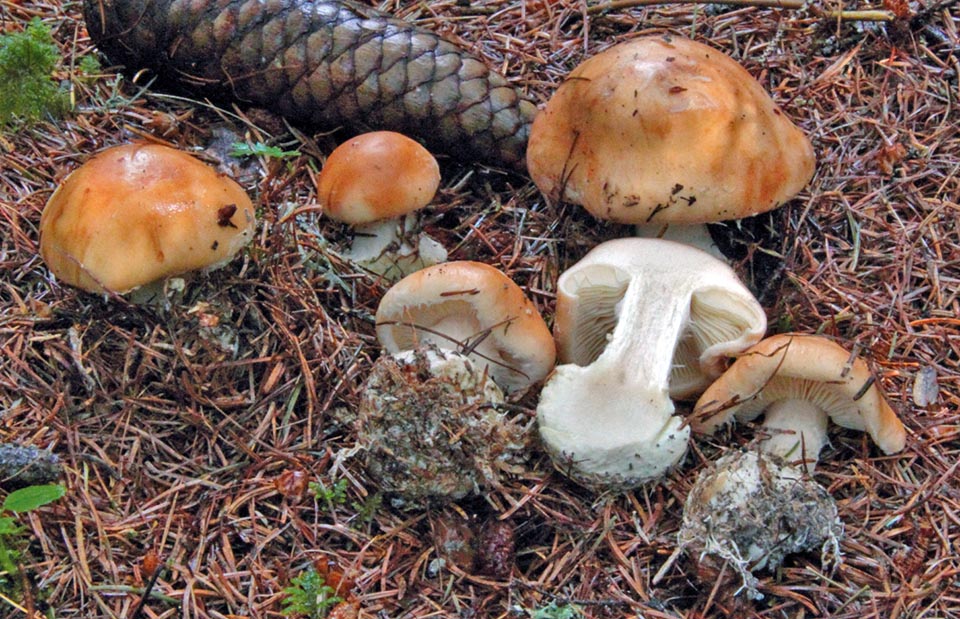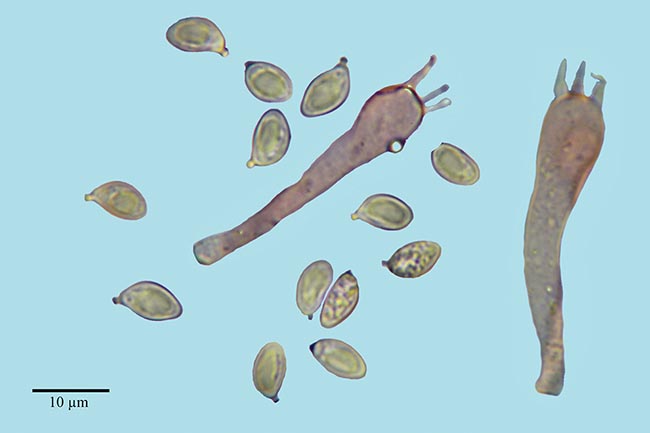Family: Tricholomataceae

Text © Pierluigi Angeli

English translation by Mario Beltramini

Leucocortinarius bulbiger is a rare species, present in Europe, growing in the sparse woods of conifers or mixed with beech © Giuseppe Mazza
To the genus Leucocortinarius (J.E. Lange) Singer 1945, is ascribed only one species: Leucocortinarius bulbiger (Alb. & Schwein.) Singer 1945 that presents with the white spores (hyaline at the optical microscope) and smooth despite the cortinarioid silhouette. Therefore, the genus is defined as monospecific and the description of the genus corresponds to that of the species.
The generic term originates from the old Greek “λευκός” (leucós), white, united to the genus Cortinarius It is therefore a white Cortinarius.
The specific term bulbiger comes from the Latin “bulbus” = bulb and from “gero” = to bring, I bring, hence, “bulb carrier” with a clear reference to the enlargement of the foot.
English name: White Webcap.

It’s characterized by white partial filamentous-membranous veil, cap mainly brown reddish and a big marginate bulb as states the specific name © Pierluigi Angeli
Cap : 5-10 cm, initially hemispheric, then convex, flat-convex, finally spinate, with or without obtuse umbo, long enrolled margin, more or less straight, at times lightly corrugated; smooth surface, glabrous, sometimes slightly scaly, finely fibrillose, more or less slimy in wet weather, of brown-ocher colour, tawny ocher, fleshy beige, up to red-brown , often with remains of the general veil especially on the edge that is covered by whitish flakes. Gills thick, broad, adnate, emarginate, sometimes decurrent for a tooth, white, whitish then cream, entire thread.
Stem : 5,0-9,0 x 1,0-1,7 cm, cylindrical, full, robust, longitudinally fibrillose, initially pure white, the pale brownish, with big basal bulb or marginate 2,0 to 3,2 cm broad. White veil rather persistent.
Flesh : fragile, soft, exiguous at the margin, thick in the centre of the cap, fibrose in the stem, white; light smell like celery, mild taste. It is edible but due to its rarity it is advisable to collect it only for studies.

Gills as white as the flesh, fragile, soft and thick in the cap but fibrous in the stem. Slight celery smell and mild taste. Because of its rarity, must collected only for study © Pierluigi Angeli
Habitat : present all over Europe, growing in mountains, in the sparse conifer woods but also mixed with beech trees, during summer and autumn.
Microscopic characters : Smooth spores, ellipsoid, with thick wall, monoguttulate; average spore 7,5 x 4,5 µm, sporal range (6,7)6,8-8,6(9,2) × 4,2-4,8(5,0) µm, Qm = 1,7 (1,4-2,0), Vm = 81 (62-114) µm3. Clavate basidia, with basal buckle joints, tetrasporic, 36,2-40,2 × 7,5-8,4 µm. Parallel lamellar texture, fertile lamellar thread. Pileipellis a hixocutis formed by loosely intertwined hyphae, gelled, with pigment intracellular but on some hyphae even encrusting with ocher-yellow colour. Thread-like veil formed by cylindrical hyphae, thin, more or less parallel, with buckle joints on all septa.
Remarks
Leucocortinarius bulbiger is a Tricholomataceae easy to recognize on the field because it presents like a Cortinariaceae but with white gills, even when ripe. It is an infrequent species but not rare growing in woods of beech and fir but also of beech and pine. Because of its look it could be mistaken with Cortinarius allutus Fr. which, however, loves the mountain woods of Norway spruce, has the gills initially white then of clay colour and the spores slightly warty.

Smooth spores, white, and clavate tetrasporic basidia © Pierluigi Angeli
Leucocortinarius bulbiger was described for the first time, with the name of Agaricus bulbbiger, by Albertini & Schweintz in 1805 as a red fungus with torn apart veil remains on the cuticle, whitish ring, with a “bulb slightly lowered at the margin, that grows in September among the leaves”.
During the following years this species has migrated in various genera depending on the interpretation of the various Authors.
Kummer (1881) placed the species in the genus Armillaria (Fr.) Staude, due to the remains of the partial veil on the stem forming bracelets.
Quélet (1886) created the genus Gyrophila to put there those fungi with convex to flat cap having an inrolled margin, adnate and sinuous gills, flesh stem, fibrillose or pruinose ring and small ovoidal spores and inserts there also this species.
In 1891 Kuntze said that this species, quite doubtful as genus of belonging, could be placed among the Lepiota P. Browne, or among the Tricholoma (Fr.) Staude because of the white and smooth spores. In any case, it adopts the genus Mastoleucomyces Battarra ex Kuntze and transfers there all the species that Saccardo cited of the genus Armillaria in the “Sylloge Fungorum” volume 5.
Ricken (1915) located this species in the genus Tricholoma due to the attachment of the gills around the stem, for the non-hygrophanous cap and for the single or gregarious growth.
Lange (1935) due to the strong resemblance with the species ascribed to the Section Sauri Fr. of the Subgenus Phlegmacium (Fr.) Trog, moved it in the genus Cortinarius (Pers.) Gray subgenus Leucocortinarius Lange.
Synonyms
Agaricus bulbiger Alb. & Schwein. (Basionym); Armillaria bulbigera (Alb. & Schwein.) P. Kumm.; Gyrophila bulbigera (Alb. & Schwein.) Quél.; Mastoleucomyces bulbiger (Alb. & Schwein.) Kuntze; Tricholoma bulbigerum (Alb. & Schwein.) Ricken; Cortinarius bulbiger (Alb. & Schwein.) J.E. Lange.
→ For general notions about Fungi please click here.
→ To appreciate the biodiversity of MUSHROOMS please click here.
